Treeing off! How to mitigate liability for claims against sports clubs and grounds relating to fallen trees

There are usually numerous trees on every golf course, particularly where the golf course borders neighbouring roads and buildings. Most outdoor sports pitches also contain numerous trees. Storm Doris in February 2017 and the recent windy weather should have highlighted to golf clubs and sports clubs that the trees on their land are capable of falling down and thereby injuring those nearby (competitors, spectators, neighbours etc…) and their property (cars, buildings etc…). Thus falling trees give rise to a major risk of public liability for golf and sports clubs and their owners. This area of law is poorly understood and many clubs are badly informed as to their legal responsibilities.
This article outlines the key components of a typical claim against a tree owner and provides some practical advice to golf and sports clubs as to the steps they can take now to protect against such claims in advance. Specifically, it looks at,
- The relevant law (the cause of action)
- Which trees should be inspected?
- When should an inspection be undertaken?
- Who should undertake the inspection?
- What should the inspector look out for?
- Practical tips of gold and sports clubs
To continue reading or watching login or register here
Already a member? Sign in
Get access to all of the expert analysis and commentary at LawInSport including articles, webinars, conference videos and podcast transcripts. Find out more here.
- Tags: Athlete Welfare | Golf | Player Safety | United Kingdom (UK)
Related Articles
- How Australia's top contact sports manage concussion
- How FIFA TMS's Global Player Exchange is changing how football clubs conduct international transfers
- Why athletes should consider career ending insurance to protect against serious injuries
- Prioritising player safety: The ICC’s new regulations for cricket helmets
Written by
Jack Harris
Jack joined 2TG in 2006, having successfully completed pupillage. Before coming to the Bar, Jack worked as a management consultant, where he worked principally with retail and public sector clients.




